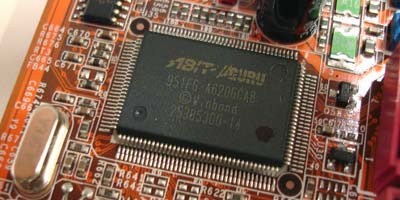Intel P965 Showdown - Abit vs. GIGABYTE
Abit AB9 Pro: Specifications & Features

Abit took a different route than Gigabyte for their Intel based boards. Instead of focusing on the P965 chipset, Abit has created a full range of 975X Express and P965 products. Their flagship motherboard is the AW9D-MAX, a decked out 975X Express board with Core 2 support (we'll have a review posted shortly). Today we'll be looking at the Abit AB9 Pro. While it's not Abit's flagship board, it's the top of their line of P965 boards and if you ignore the lack of a second PCI-E x16 slot, the AB9 Pro is actually better specified than the AW9D-MAX! The AB9 Pro has a lot of nice features packed into it like onboard dual gigabit LAN, Abit's uGuru technology and more SATA ports than you'll likely ever need.
|
|
|
|
CPU
Chipset
Front Side Bus
Memory
Expansion Slots
Audio
LAN
Special Features
|
Back Panel I/O Ports
Internal I/O Connectors
Accessories
Form Factor
|
While the GA-965P-DQ6's eight SATA ports was impressive, you won't be disappointed by the AB9 Pro as it supports up to 10 SATA devices. The AB9 Pro has nine SATA ports on the board itself and an additional eSATA port on its I/O panel. The AB9 Pro loses when it comes to PCI-E slots, however. With support for only one PCI-E X16 slot and two PCI-E X1 slots, it falls behind the DQ6 by a total of two slots. While the DQ6 had Gigabyte's 6-Quad and S-series feature sets, Abit has given the AB9 Pro their SoftMenu, uGuru and Silent OTES technologies.
|
|
|
While we now take CPU frequency and voltage adjustments in the BIOS for granted, it was Abit that pioneered the idea. Softmenu was one of the first jumperless CPU configuration systems to appear on a motherboard. Before it, many adjustments required for overclocking had to be done via jumpers. Since its inception, SoftMenu has been a staple feature on Abit boards and copies of its concept can be found in the BIOS of just about every modern enthusiast motherboard.

Abit uGuru Chip
Abit extended their SoftMenu idea and the result was uGuru. uGuru is a custom microprocessor that, in conjunction with Abit's software utilities, allows the user to modify system settings and monitor system status in real-time from within the operating system. The dedicated uGuru chip allows all of this to be done with zero CPU utilization. The ability to modify and monitor system settings like frequency and voltages in real time greatly simplifies the process of overclocking. Being able to do all of this from within Windows means that finding an optimal overclock no longer requires rebooting the system a hundred times to get into the BIOS for more tuning.
The AB9 Pro is outfitted with the latest uGuru chip, located at the bottom of the board, under the main group of SATA ports. Included on the driver CD are four utilities designed to take advantage of the uGuru's capabilities.

|
The OC Guru utility allows you to view and modify overclocking settings. You can also create, set and apply overclock presets. This utility also controls AutoDrive, which automatically applies different overclocking settings that you configure based on the applications that are running. |

|
The Abit EQ utility allows you to monitor voltages, temperatures, and fan settings in real time with no CPU usage. It also has a temperature warning ability. It can sound an alarm or automatically shut down the system if the temperature exceeds a certain user customizable level. Lastly, the Abit EQ utility works with the Black Box utility to generate data that Abit technical support can use to assist you. |

|
FlashMenu is designed to assist in the flashing of your BIOS. It can download and flash the latest BIOS, as well as create BIOS backups and flash from previously saved BIOS files. |

|
The Black Box utility is designed to assist Abit technical support assist you. It can display important system information and even send this information to Abit technical support. The Black Box utility also has a "Sendmail to ABIT" button that, when pressed, sends a request for technical support along with system information to Abit. |
All told, the uGuru's features are quite helpful and can save you a lot of time. The OC Guru utility is especially useful and the EQ utility is a great alternative to traditional in-OS hardware monitoring methods, especially since it uses almost no CPU cycles.

Silent OTES Heatsink
In 2004, Abit introduced the OTES cooling system. This is a heat pipe based cooling system designed to transfer heat from the chipset and voltage regulators and expel it out of the system through slots in the rear I/O panel. The AB9 Pro makes use of a fan-less passive version this system, hence the addition of "Silent" to the name.







